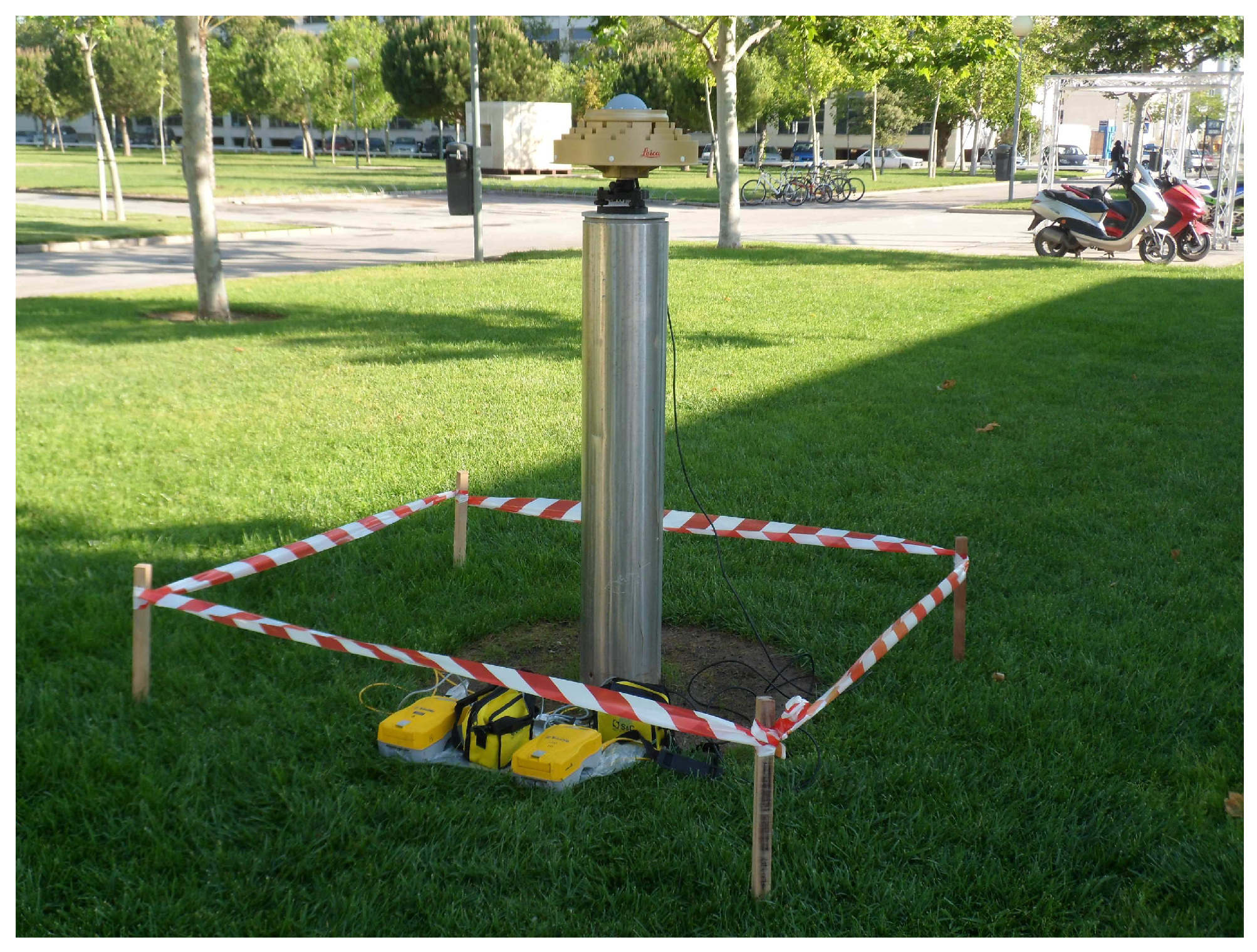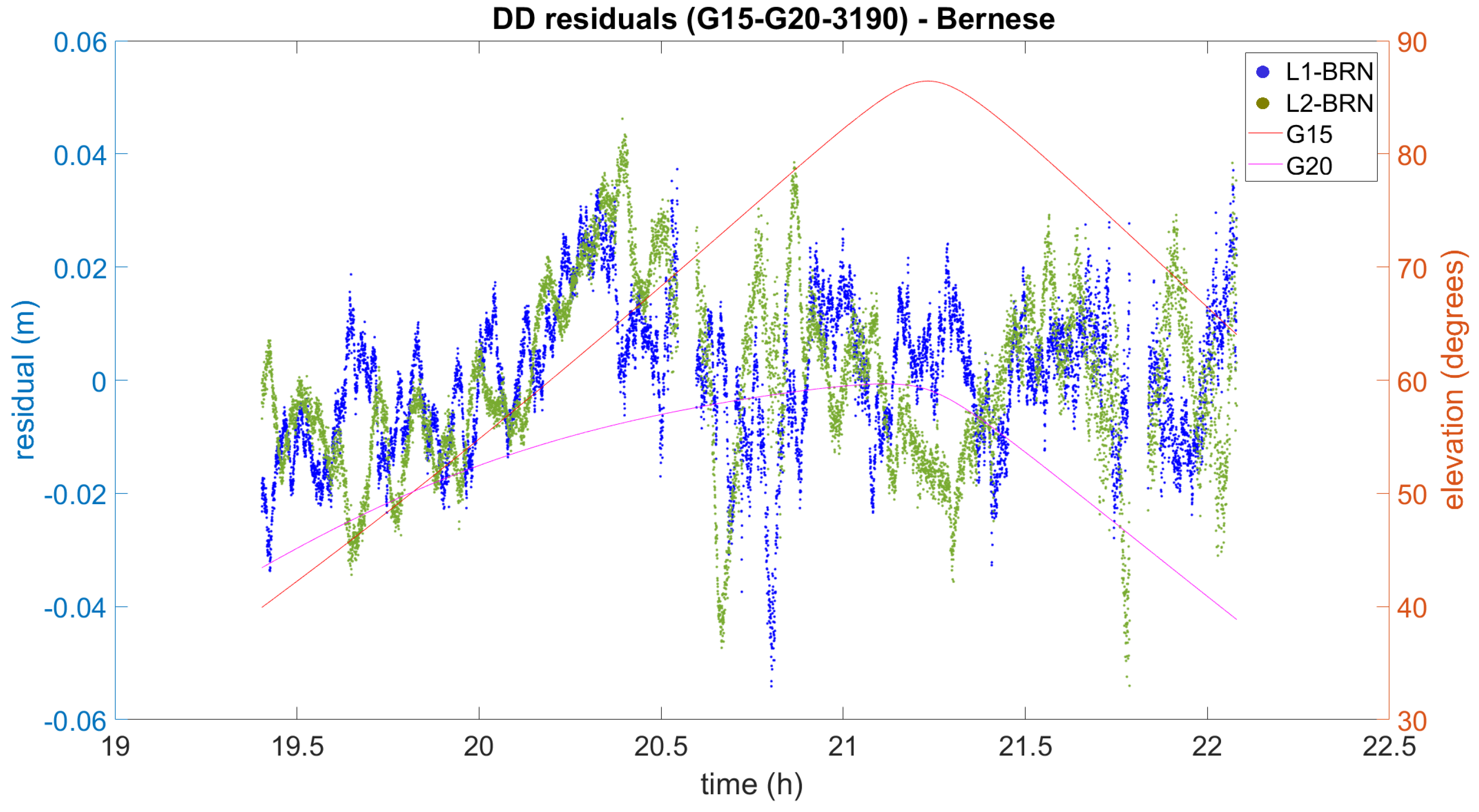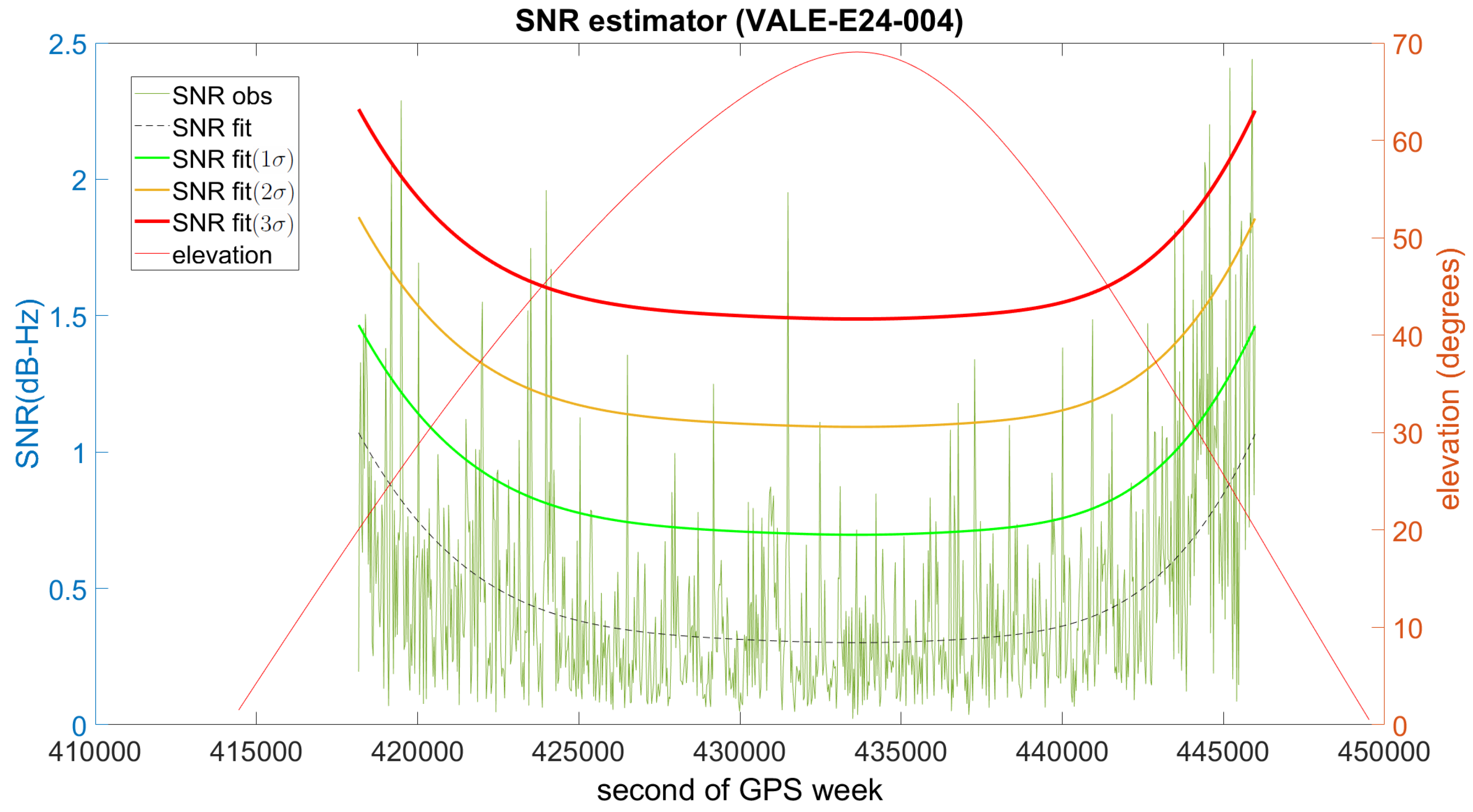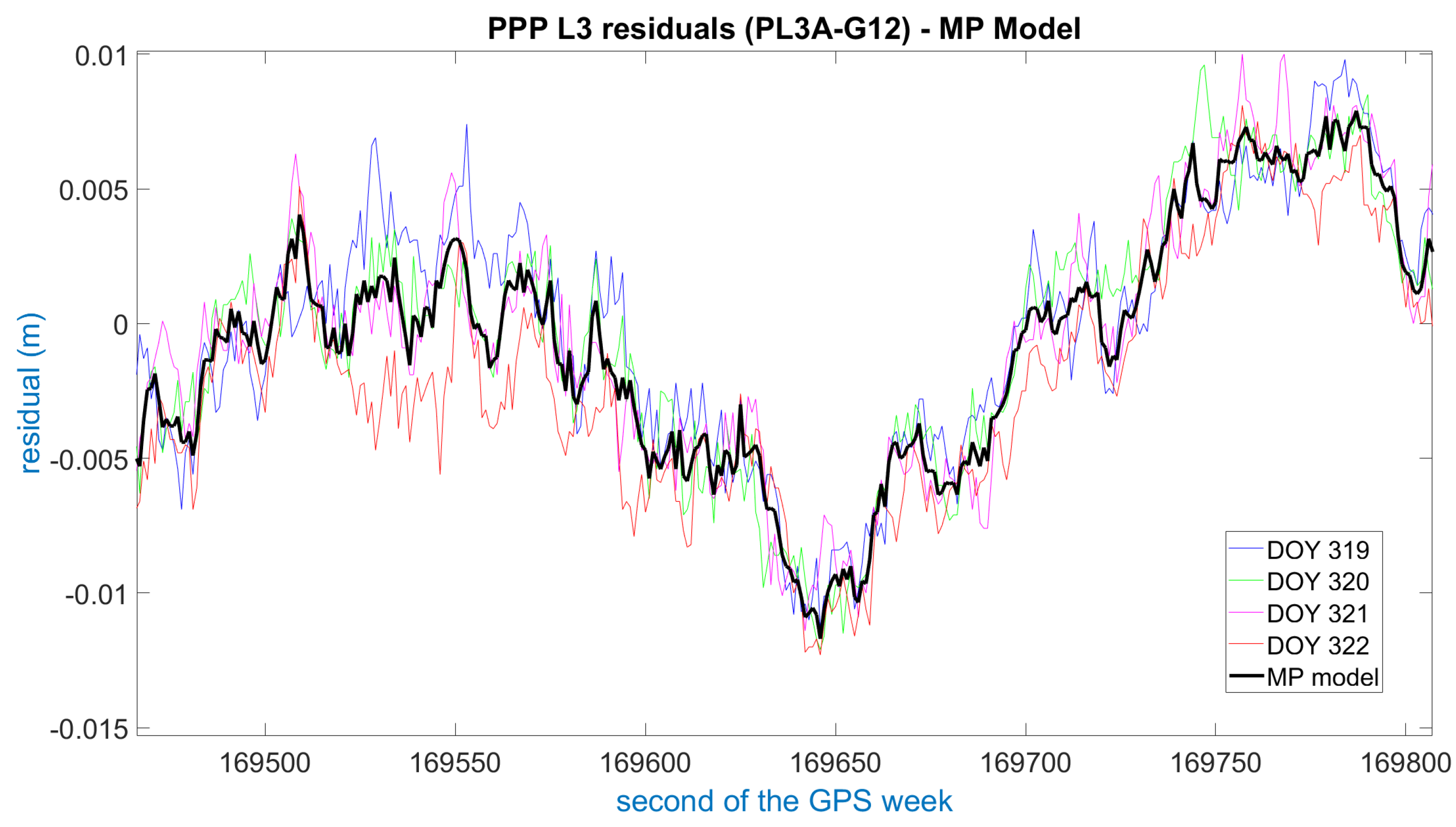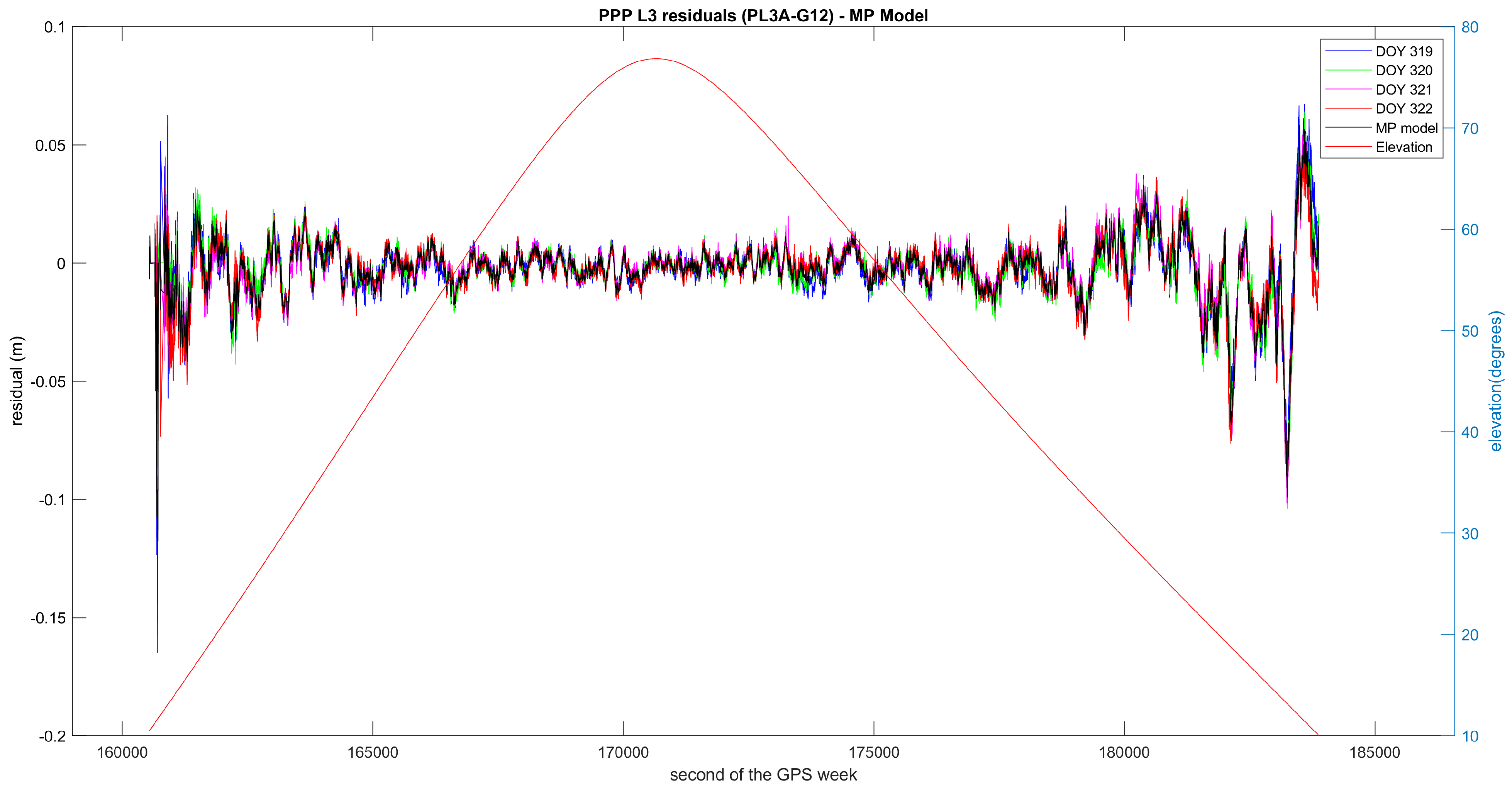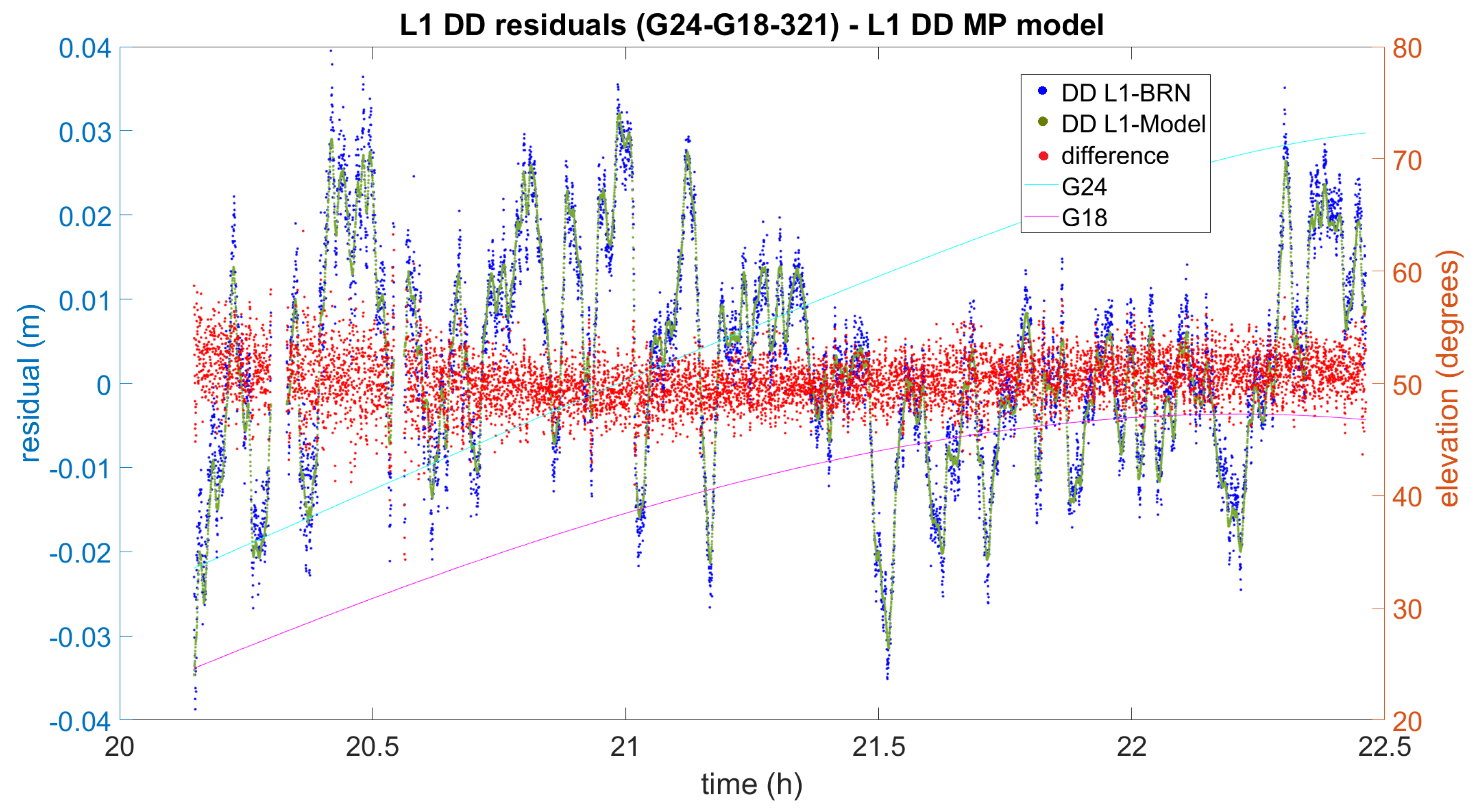1. Introduction
Absolute distance determination in the open air with an uncertainty of a few tenths of a millimetre is increasingly required in fields such as length metrology, high precision geodetic metrology, deformation monitoring at critical sites or local ties in Fundamental Geodetic Observatories (FGOs) [
1,
2,
3].
In the present context, the term absolute refers to the fact that distances have to be consistent with the metre, the unit of length of the International System of Units (SI) which is currently defined as the length of the path travelled by light in vacuum during a time interval of 1/299792458 of a second [
4]. This definition of SI-metre is realized by the National Metrology Institutes (NMIs) with a standard uncertainty
by using laser interferometers with stabilised frequencies, though such a high accuracy can only be obtained for short distances, i.e., several metres, under laboratory conditions. Following the core concept of metrological traceability, those references or primary standards are subsequently transferred or disseminated from laboratories to outdoor metrological facilities that are also known as calibrations baselines. These calibration baselines, whose inter-pillar lengths usually range from 10 m to 1000 m, are then used as secondary and working standards for practical purposes [
5,
6,
7].
The only calibration baseline that has proved stable with a relative standard uncertainty near
for more than 70 years is the Nummela Standard Baseline (NSB) in Finland (864 m), and thus acknowledged as international standard in geodetic metrology. Such a high accuracy can only be obtained by using the Väisäla interferometer which has the additional metrologic advantage of being directly traced to SI-metre [
8,
9,
10]. With this method being very demanding, the NSB inter-pillar distances are measured only every five years by the Finnish Geospatial Research Institute (FGI), although its accurate scale can be traceably transferred to other baselines of reference by using submillimetric Electronic Distance Meters (EDM) like the Kern Mekometer ME5000 (ME5000) which was manufactured in the late 1980s [
11,
12].
Nevertheless, the use of the out-of-production ME5000 entails two problems. Firstly, only a few units of this type of EDM are still in use, and secondly, having only one carrier phase (0.628 nm), the air refractivity has to be determined with an accuracy better than 0.1 ppm by using meteorological sensors, which is rather difficult for distances longer than 1 km [
12]. Consequently, new techniques such as multi-wave interferometry, two-wave laser telemeters or laser trackers are currently required to go beyond the ME5000 [
13,
14,
15]. Yet the research effort is considerable, and it demands joint projects like the current 18SIB01 GeoMetre—large-scale dimensional measurements for geodesy’ which has received funding from the EMPIR programme co-financed by the participating states and from the European Union’s Horizon 2020 research and innovation programme [
16].
A possible alternative to those expensive techniques is the use of Global Navigation Satellite Systems (GNSS) to develop a GNSS-Based Distance Meter (GBDM). Some experiments that compare GNSS distances with EDM distances can be found in the literature, but being most of them based in the use of commercial GNSS software and EDM instruments, the differences between these two techniques can easily reach around 3 mm [
17,
18]. The GBDM as a potential technique for length metrology was firstly analysed in the EMRP-JRP 3.1-TP 3 ‘Length’ [
19], and subsequently in the EMRP-JRP SIB60 ‘Surveying’ [
20]. Most of the studies were performed by using state-of-the-art geodetic software, i.e., the Bernese 5.2 [
21], along with the most advanced geodetic products and models. The reporting document for the GBDM technique recommends the use of carrier-phase double differences (DD), and points out that GNSS signal multipath is the major limiting factor to get submillimetric accuracy, but no recommendation is given concerning a possible standard strategy for optimal GNSS processing and some metrological questions such as uncertainty determination or traceability are considered still open [
22]. Consequently, some criticism still remains for the GNSS to be used as a submillimetric technique for length metrology.
However, previous research conducted at the Department of Cartographic Engineering, Geodesy and Photogrammetry of the
Universitat Politècnica de València (DICGF-UPV) showed the potential of GNSS techniques in terms of reproducibility for measuring distances over several hundred metres with uncertainties below one millimetre by using a functional model different from the traditional geodetic approach along with robust estimation [
1,
23,
24]. The initial assumptions, the functional models and the intended computing approach are described in
Section 2.
As previously mentioned, the GNSS signal multipath error is considered the major limitation to use a GBDM in current metrologic facilities. The traditional geodetic approach to cope with this problem is to carefully select the GNSS sites and average out the multipath error by using long observation span times. However, current calibration baselines of reference [
10,
25] were mostly set up decades ago, and they do not always have favourable conditions for GNSS measurements since they are normally surrounded by trees or buildings. As a result, L1/E1 DD residuals can easily reach up to several centimetres with no Gaussian distribution and consequently the obtained distance will be biased, thus impeding the desired submillimetric accuracy. Therefore, a consistent GBDM should include some processing strategy for multipath mitigation. Therefore, the last field experiment was specially designed to investigate and develop possible methods for multipath mitigation as applied to length metrology. This part of the investigation was conducted at the Space Geodesy and Navigation Laboratory of the University College London (SGNL-UCL), and their results are shown in
Section 3.
Nonetheless, not only does the GBDM technique have to be proven to be precise but it must also be accurate according to length metrology standards. Thus, the proposed GBDM technique was tested in four field experiments conducted at the UPV submillimetric calibration baseline from the years 2013 to 2016. Each experiment was a four-day campaign where both the GNSS and EDM techniques were applied. During the daylight hours, the inter-pillar distances of the calibration baseline were measured using a ME5000 in accordance to ISO17123-4 [
5], and subsequently, GNSS antennas were set up to collect twelve-hour sessions overnight. The same operational scheme was repeated for four consecutive days. The experiment was designed in such a way that the obtained distances can be traced to the SI-metre.
This paper is organised as follows. In
Section 2, the general approach for GNSS data processing is described.
Section 3 is devoted to the methods for multipath detection and mitigation that were developed and tested. The assessment of the resulting accuracy by comparison with distances derived from EDM traced to the SI-metre definition in a calibration baseline is explained in
Section 4. Finally, some conclusions and future work are summarised in
Section 5.
3. GNSS Multipath Mitigation
The GNSS multipath error arises from the fact that the signal from a satellite arrives at the antenna via multiple paths due to reflection and diffraction. These indirect-path signals can distort the received signal by up to one quarter-cycle and this error does not cancel or mitigate when forming the double difference combination. Therefore, GNSS multipath becomes a critical source of error in high precision applications [
28,
35], and even more for length metrology because most of the current calibration baselines of reference, which were set up decades ago before the advent of the space geodesy era, are surrounded by objects such as trees, buildings or other facilities.
Multipath interference can be separated into near-field and far-field effects, which do have different properties. Near-field multipath results from the closest vicinity of the antenna, i.e., the first 50 cm around the antenna, and mainly leads to a systematic bias that can be prevented by creating identical near-field situation in all stations which involves the same type of pillars, GNSS antenna model, antenna mounting, and routing of the antenna cable. However, the near-field can also change the electronic properties of the antenna and thus, individual antenna calibrations can be considered accurate as long as the actual near-field situation was reproduced during the calibration procedure. Nonetheless, this refinement is not usually included in the calibration process due to size and weight limitations and it would only make sense if each calibrated antenna was always setup in the same pillar [
22,
35,
36,
37].
On the other hand, far-field effects arise from reflecting surfaces in the environment of the antenna such as trees or buildings, and for static surveys, which is the case at hand, lead to short periodic errors. Following the traditional geodetic approach, the far-field multipath is generally assumed to average out by sufficiently long observation times [
35,
38,
39]. In consequence, this approach is particularly valid for permanent GNSS stations which have a favourable observational environment and 24-h sessions but cannot always be applied to calibration baselines and short time spans. Our initial approach to cope with multipath was based on the use of the signal-to-noise ratio flag and global robust estimation [
40].
Interestingly for our study, the trees surrounding the UPV calibration baseline, which were young in 2012, are increasing in size as the years go by. As a consequence, our former approach to cope with multipath, based on the use of the signal-to-noise ratio flag and global robust estimation [
40], cannot be successfully applied under these new conditions. To give a picture of the problem, some DD residuals which were obtained in our experiment are plotted in
Figure 3. It can be clearly seen that the L1 DD residuals range from 0.04 m to −0.05 m and they cannot be considered Gaussian. Therefore, the obtained distance will be biased. In addition, the L2 DD residuals are bigger, as expected, and follow a different pattern than the L1 DD residuals. Similar residuals were found in other DD combinations.
Over the last 10 years, the Space Geodesy and Navigation Laboratory of University College London (UCL) have developed and successfully applied techniques for GNSS multipath detection and mitigation, some of them suitable for GNSS processing for distance determination [
31,
32,
41,
42]. Specifically, we have now implemented the observation-domain sidereal filtering technique and the signal-to-noise ratio (SNR) estimator.
The sidereal filtering technique [
31,
32] takes advantage of the consecutive passes of each satellite to predict the multipath error. As long as both azimuth and elevation repeat for the same satellite, the multipath effect can be considered similar, and subsequently corrected. For GPS satellites, the repeating time is one sidereal day, which makes the technique attractive to use if data from consecutive days are available, whereas for Galileo satellites the repeating time increases to 10 sidereal days and the use of the technique would require GNSS observation sessions 10 days apart, which is impractical. In what follows, we will restrict the application of the sidereal filtering technique to GPS observations only.
In contrast, the SNR estimator does not provide a value for the multipath error [
41]. By differencing SNR measurements on different frequencies and comparing the result with that obtained in a low-multipath environment, multipath can be detected. The result is a number that can be used, in theory, to identify the presence of multipath.
To characterize a low-multipath environment, we opted for the VALE permanent station. It is only 100 m away from the UPV calibration baseline and its equipment (Leica GR10 receiver and Leica AR25.R3 antenna) is very similar to the equipment used in our experiment described in the next section.
Figure 4 shows the SNR estimator for the Galileo satellite that was selected as a low-multipath reference. The line in black is the expected value, and in green, orange and red are respectively the
,
and
thresholds. If the estimator is clearly above the red line, multipath is considered to be present.
Both techniques, sidereal filtering and SNR estimator, may be complementary. This is important since each technique may on certain occasions yield null values even when multipath is present. Conversely, depending on some aspects of the PPP implementation, e.g., cycle-slip detection and correction strategies, the residuals obtained could be abnormally high with no relation to multipath. However, matching residuals by using azimuth and elevation has clear advantages over time. First, the technique is independent of the value of multipath and does not need to rely on the identification of the correct satellite repeat period (a significant problem so far, as pointed out in Reference [
43]). Second, the multipath model could be eventually parameterised in terms of azimuth and elevation even for the satellites with low multipath.
In summary, the whole process to mitigate multipath in the context of GBDM consists of the following four steps
To obtain a PPP solution for each site and for every day using an ionosphere-free combination.
To match the ionosphere-free observation residuals on successive days using azimuth and elevation in order to obtain a site-specific and time-specific multipath model for an ionosphere-free combination.
To form ionosphere-free DDs using the obtained multipath models with the same DD scheme that will be eventually used in the final L1/E1 solution.
To determine the L1/E1 DD multipath corrections from the previous values by using DD residuals from an independent DD solution and the same ionosphere-free combination that was used to obtain the PPP solution.
In the first step, the PPP solution is obtained with an epoch-wise processing strategy that uses an ionosphere-free combination with floating ambiguities. Some advantages of this straightforward approach are that the bulk of the ionosphere error is removed, the multipath error is amplified with respect to that of the original observed frequencies, and it can be implemented in real-time if desired.
Nevertheless, part of the multipath error could slip into other parameters and errors caused by the imperfect modelling of other parameters (receiver clock, troposphere delay, phase ambiguities) could be wrongly considered as multipath. For that reason, it is relevant to look for a repeating pattern in the second step. Only the residuals that follow a sidereal pattern can be considered as multipath error. Once the consecutive days are matched using azimuth and elevation, the median of the residuals is retained as multipath error. The result is a site-specific and time-specific multipath model for the combination used in the PPP solution. Interestingly, the model formed may contain some possible antenna calibration mismodelling since this error also repeats with azimuth and elevation.
In the third step, the site-specific and time-specific models that were built up for each satellite are combined to form the required ionosphere-free DD residuals. This combination largely cancels those components of the residuals which originate in the satellites, such as orbits and clocks, those related to the receiver clock offsets and possible residual atmospheric errors.
Finally, the L1/E1 DD multipath corrections are obtained for each day by using the ionosphere-free DD corrections and the corresponding DD residuals from an independent DD auxiliary solution. For that independent DD solution several frequencies such as L2, L5, E5a or E5b can be used as long as they were employed in the PPP solution. Obviously, the noise of the new multipath-corrected DD equation is higher then the original one, but that is not a problem for the case at hand as long as the multipath error is mitigated in such a way that the resulting distance is not biased.
The observation-domain sidereal filtering for GPS Precise Point Positioning (PPP) developed at the SGNL-UCL [
31] uses the ionosphere-free linear combination
with the following combination factors
Please note we have chosen the notation , which is used in the Bernese software, to be consistent with and .
The formed
combination has a wavelength
and with standard noise values
mm, the resulting
noise is
Nonetheless, modern receivers can measure the carrier phase with better precision and from our experience the values mm are more realistic so that the resulting noise for the combination can be considered around 3 mm.
Since the noise of the ionosphere-free combination is
mm, the obtained DD residuals are expected to have a theoretical noise
mm that could hamper the determination of a
site-specific multipath model by using a PPP approach. Surprisingly, if
residuals are obtained straight from the
residuals by substracting the corresponding
residuals, the resulting residuals have a noise
mm. The reason is that the coefficients are smaller than one.
and therefore,
Figure 5 illustrates the PPP ionosphere-free phase residuals for pillar 3 (PL3A) (see
Figure 1) and satellite G12 after the matching process. As can be seen, the residuals from the four consecutive days of the experiment are consistent and show a clear sidereal pattern. Therefore, the initial assumption for the PPP residuals to be mostly multipath error is confirmed. When the residuals from the consecutive days are compared with each other, the differences are normally below 5 mm, thus confirming the correctness of the functional model used in the PPP implementation and its suitability for this application. Nevertheless, in some cases the PPP residuals differ by up to 1 cm, possibly due to a slightly different satellite trajectory, different humidity of the ground or technicalities of the particular PPP implementation. In those cases, there is still some consistency between days, and normally only one day at a maximum is different from the rest, so that retaining the median as the multipath value for the model usually solves the problem.
The figure above is a zoomed-in excerpt from
Figure 6, which shows the residuals and the multipath model for the entire observation time for this particular satellite, that is, the approximately 6.5 h the satellite has been with an elevation above 10°. Evidently, the observations of low elevation are strongly affected by multipath and should not be used for precise positioning.
Now let us focus on the impact on DD processing. In
Figure 7,
Figure 8 and
Figure 9 the difference between the initial L1 DD residuals obtained from the Bernese solution (blue) and the L1 DD multipath correction given by the proposed multipath mitigation method (green) are plotted (red) for three different DD combinations and days. In the three examples, the L1 DD multipath error is mitigated and the new observed minus computed value is lower than one centimetre on average. The three examples also show that the proposed method seems to work independently of the elevation of the satellites, and even in the presence of data gaps.
As it can be seen
Figure 7, the range of the obtained differences is 5 mm on average. However, some values at around 20.6 h have an absolute value of about 2 cm with residuals peaking −5 cm. Even in that case, the influence of the multipath error is largely diminished in the new observed-minus-computed-term, and the overall impact on the distance obtained can still be considered unbiased.
The example in
Figure 8 shows higher residuals that reach up to 8 cm. In this case, the bandwidth of the differences is over 1 cm, and slightly higher if compared to the previous example. Again, the differences seem to be randomly distributed around zero and no impact is expected in the subsequent obtained distance.
Finally, the example given in
Figure 9 has been chosen because the differences between the initial L1 DD residuals and the multipath corrections seem to be not so well centred as other DD combinations. In this case, although the overall range of the differences is over 8 mm, it can be seen that it is wider and slightly biased when both satellites are at a low elevation.
